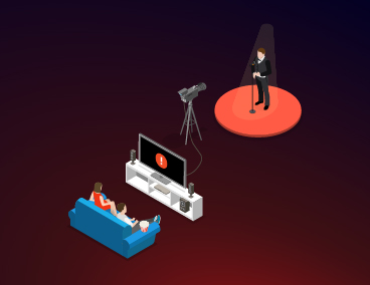I spent a few days recently at the Gartner Symposium/ITxpo 2018 in Orlando. During that time, my colleagues and I had the chance to talk to hundreds of CIOs and senior IT executives. I also had a fascinating conversation with Michael Miller, CIO of Ziff Brothers Investments (and formerly Editor in Chief of PC Magazine). Here are three major take-away CIO themes from this year’s Symposium.

1. Security is Still an Existential Matter
I think the whole industry sat up and paid attention when both Target’s CEO and CIO resigned in the wake of the 2014 data breach, effectively serving notice to IT execs that you can lose your job if you’re hacked. With more and more business processes moving to the cloud, with digital transformation extending the boundaries of the network out across the far reaches of the Internet through SaaS and API-based microservices, the world has moved to a zero-trust model. Security is still the top consideration for many if not most CIOs. It’s what keeps them up at night. According to the Gartner 2019 CIO Agenda survey, CIO’s are still the role most likely to be responsible for cyber-security and 95% of them believe that security threats will continue to increase.
For our part, we’re starting to see organizations that are digitizing their businesses pay keen attention to factors such as BGP hijacking and DNS hacking. This concern has grown with reminders like the BGP hijack of AWS Route 53 service earlier this year. However, as we found in the ThousandEyes Global DNS Performance Benchmark Report, there is still a good amount of awareness and education needed in terms of ensuring the resiliency of key assets like DNS. According to our research, a majority of large enterprises are unready for another Dyn-style attack on DNS and are vulnerable to their online brands being taken offline as a result.
We’re also hearing more organizations move to always-on DDoS mitigation services, but with that come concerns about how mitigation services are performing and delivering user experience. One of the things that is often missed when going to always-on DDoS mitigation is that the security provider effectively becomes your ISP. Any hiccup in their performance will impact digital customer experience, even if that hiccup is due to collateral damage from handling attacks on customers aside from you.
2. So We Moved to the Cloud, Now How Do We Manage It?
A theme that came out consistently was that for most organizations, the move to the cloud is well underway. According to the Gartner 2019 CIO Agenda Survey, 33% of organizations report having reaching digital scale (up for only 17% a year ago). Now, the challenge is in managing the cloud. That includes managing cloud infrastructure, orchestrating applications and microservices across hybrid and multi-cloud scenarios, governance, performance and user experience. As we spoke to so many CIOs and IT execs, the combination of loss of control and lack of visibility resonated as a major challenge of operating in the cloud. The need to see, understand and optimize the performance of the myriad external network, infrastructure and service dependencies within the Internet and cloud providers is very present across organizations that have migrated to the cloud.

From my perspective, this state of cloud adoption and the operational challenges and business impact that arise from it explains why we’ve seen such a strong adoption rate for Network Intelligence. Network Intelligence provides visibility into digital experiences and all their myriad and layered external (and internal) IT dependencies.
3. AI is Awesome. Can’t Wait to Use It. Now What is It?
A huge theme in the conference in general, but also as a buzzy topic of discussion at Symposium amongst a lot of participants was AI. Yes, the AIOps spaceship has touched down on planet Gartner with flashing strobes. The number of companies sporting AI messaging was impressive, Microsoft had an AI-theme space for example, with signage addressing how AI in Office 365 helped ensure more efficient search and retrieval of documents and messages.
While there is a ton of interest in the topic, there is still some healthy skepticism as to what AI as used by vendors really refers to. Michael Miller’s observation was that much of what is talked about as AI is primarily a rebadged version of Robotic Process Automation (RPA), which is definitely useful but not so much self-learning as advanced pattern matching.
From what I can see, there are two major approaches taken by AIOps tools. One approach is to offer a big data repository platform (like Splunk) that allows for forensic analytics on massive volumes of historical structured and unstructured data on a sophisticated, multi-dimensional basis using advanced pattern matching. The other approach is to utilize advanced pattern matching to extract anomalies from a streaming data pipeline, only retaining and acting on that which is of interest.
The explosion of AI into the IT Ops arena reminds me of a conversation I had some months ago with the head of the AI practice at a big five consulting firm, who mentioned that their AI practice was by far the fastest growing segment of their practice, as businesses embraced the power of advanced pattern matching to solve non-IT work process challenges problems like detecting credit card fraud. We should see a growing uptake of AI in IT Ops as well, in steadily advancing forms.
Everything is Bending to the Shape of the Cloud
The move to the cloud and Internet, dependence on an unpredictable and unregulated Internet with all its uncertainties and insecurities, is at the root of so much change and ferment in IT today. CIOs have traded control for agility in the cloud and the Internet, but need security, visibility and more efficient ways to manage a reality where there is no longer any steady state. It was helpful to observe, and exciting to interact with so many IT executives and organizations in one place. I’m already looking forward to Gartner Symposium/ITxpo 2019!


